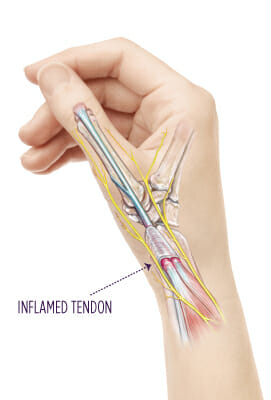

What is De Quervain’s tendinitis?
De Quervain’s tendinitis (also called De Quervain’s tenosynovitis) is an inflammation of some of the tendons that extend the thumb. These tendons pass through a narrow, close-fitting cover of tissue. The tight space can cause irritation. Once tendons are inflamed, the pain-inflammation cycle can be difficult to overcome without treatment.
What causes De Quervain’s tendinitis?
Inflammation can be caused by a number of things:
- Starting new activities in which there is significant repetitive motion of the thumb or wrist
- Fractures
- Arthritis
- A tight cast
De Quervain’s tendinitis is also very common in new mothers or those caring for very small children.
What are common symptoms of De Quervain’s tendinitis?
There is a range of symptoms associated with tendinitis. They include, but are not limited to:
- Pain at the base of thumb and/or wrist
- Painful clicking and popping
- Swelling over the irritated area of the wrist
- Weakness with certain movements
- Burning pain or tingling over the tendons in this area
What are my treatment options for De Quervain’s tendinitis?
Summit’s hand care team will work with you to develop a treatment plan designed to get you back to your everyday active life.
As a first step, your doctor may inject a numbing medication into the painful area. This injection is diagnostic and can help formulate a plan tailored to your needs.
Common treatment for symptoms includes:
- Splint to stop thumb and wrist movement
- Anti-inflammatory medicines
Treatment to change the course of the disease includes:
- Cortisone injections
- Surgery to open the tunnel and make more room for the tendons
How long does it take to recover from De Quervain’s tendinitis?
Once painful symptoms have subsided, your Summit hand surgeon will likely recommend a strengthening exercise program for your thumb and wrist.
Your recovery time is dependent on your age, general health, and how long your symptoms have been present. With cases that have developed over time, De Quervain’s may take longer to respond, since the disease is often more resistant to change.
